As a result, there will be extremely slow occultations by Jupiter's atmosphere (four times), and also by Jupiter's rings and probably, Jupiter's satellites, between 1 April (no hoax!) and 9 April 2003.
Astrometry
08h 42m 42s.4731
+19d 05' 58".880
Photometry
B=12.07 (B-V = +0.45 Sun : +0.65)
V=11.62
R=11.02 (V-R = +0.60 ,, : +0.54)
I=10.61 (V-I = +1.01 ,, : +0.88)
J=10.31 (V-J = +1.31 ,, : +1.12)
H=10.02 (V-H = +1.60 ,, : +1.43)
K= 9.89 (V-K = +1.73 ,, : +1.49)
Science
Atmosphere
The atmospheric occultations can be attempted in the methane band at 0.9 microns, or better, in K (2.2 microns). We did observed a stellar occultation by Jupiter in October 1999 with a K= 9.9 star, and the contrast star/Jupiter's limb was very good.
Small satellites
The small inner satellites are much more likely to cause usable occultations as they are much fainter.
An interesting issue is the possible detection of small unknown satellites, as the small ones presently detected near the main ring (namely Metis, and Adrastea, with radii ~ 10-20 km) are probably the tip of a larger population of as-yet unnoticed km-sized or less chunks.
The greatest concentation of these small bodies is expected in the main ring region, between 128000 and 129000 km from the planet center.
Rings
The April ring occultation has two favourable circumstances with respect to the event in 1980: (1) slow motion of the star wrt the rings, resulting in a better signal/noise and (2) almost edge-on view (elevation= 0.2 deg) of the rings, resulting in an amplification by a factor of ~ 300 of the normal optical depth of the main ring.
Still, the optical depth of the entire main ring will remain very small, and thus a detection will be difficult. Rather, one might expect to detect some large particles (or small satellites) in this ring, as explained above.
If positive, however, a detection of a dusty ring by simultaneous observations at various wavelengths might help understanding better the size distribution of the jovian rings.
It is important to note that the star will cross TWICE the ring orbit. For instance, the close up view for Pic du Midi (see below) shows that the star will scan for about 10 mn the main ring region around 23:40 UT April 6, and then again for about 10 mn around 00h25 UT April 7.
You may figure out you own shedule according to the maps below. Thus my advice is to stay on the star for at least one hour around the nominal middle time for the all event, or more if possible, in order to carefully scan the ring region.
It is also important to note that we are looking not only for a faint absorption during the ring crossing, due to dust, but ALSO and mainly for brief and deep occns caused by small satellites (or large particles) embedded in the ring region. Such brief interruptions should be confirmed by another redundant nearby instrument if possible, as they might arise from bird passing by, clouds, electronic glitches, etc, etc...
A reference star (or satellite) is important! There is one at 2'04" NNW of the occulted star, which has about the same V mag, see the field below. A possibility to save acquisition time is to have two small windows, one on the occulted star and the other one on the reference star.
In case you cannot reach a photometric reference object (satellite or star) you may use as a better than nothing backup some benchmark on Jupiter's disk.
According to the diameter and quality of your mirror, the transparency of the sky, the distance of the star to the planet limb and the sensitivity of your receptor, you may try various configurations (I band, wide CH4 filter, narrow CH4 filter, mask on Jupiter, etc...) to see what is optimum for you.
Geometry
General views of the stellar tracks as seen from Pic du Midi (France),
La Palma (Canaries Islands, Spain), La Silla (ESO, Chile), Palomar
(California, USA), Max Valier Observatory (Italy) and New Jersey (USA).
The dots are plotted every hour, the squares are plotted every 24
hours. The continuous curve is the geocentric track.
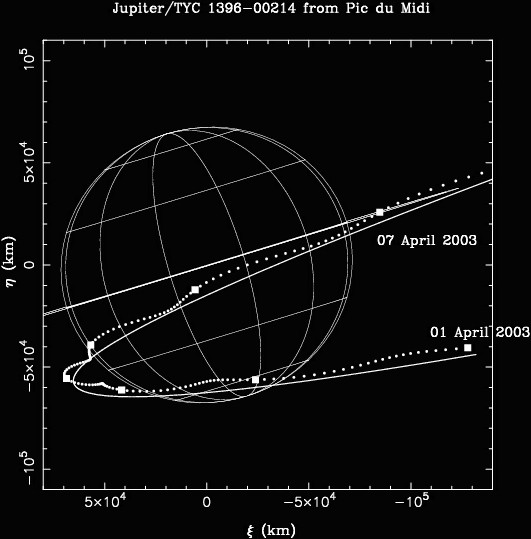



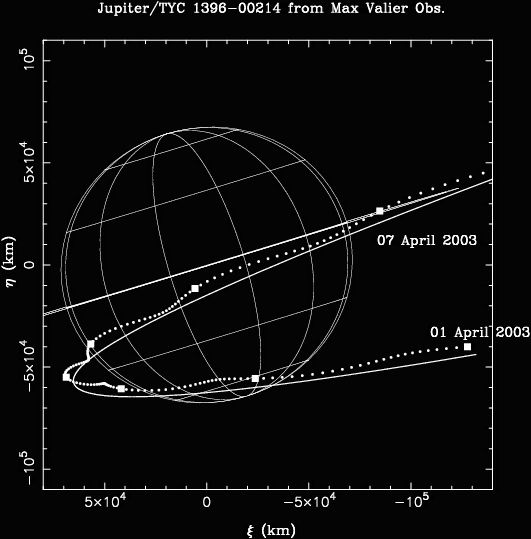

Detail of the ring occultations as seen from Pic du Midi, La Palma,
La Silla and Palomar:

... and from Max Valier Observatory and New Jersey:
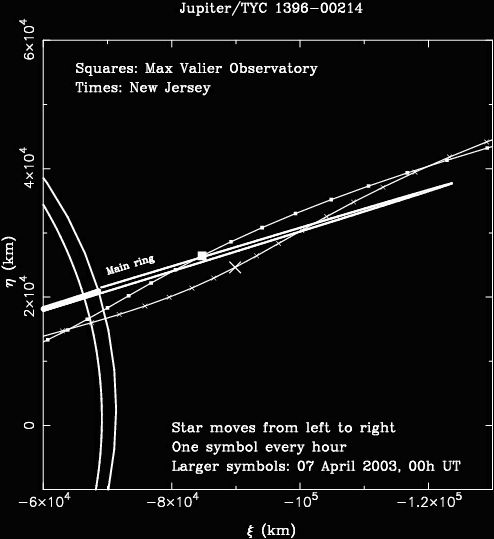
... and from Nyrola Observatory (Finland)
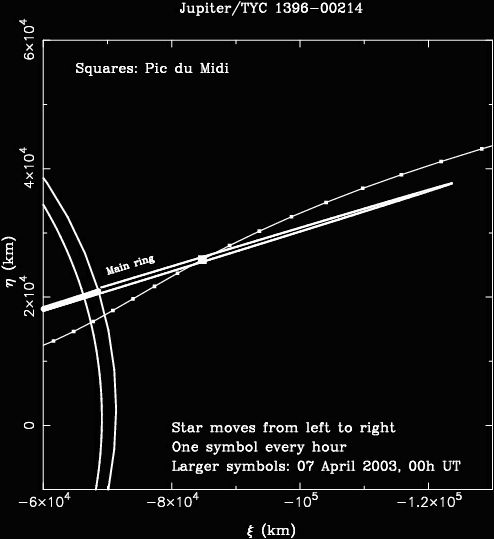
... and from Livermore (CA, USA)


... and more details on the Pic du Midi observational circumstances:


Field of view on April 07, 00h UT, as seen from Pic du Midi:
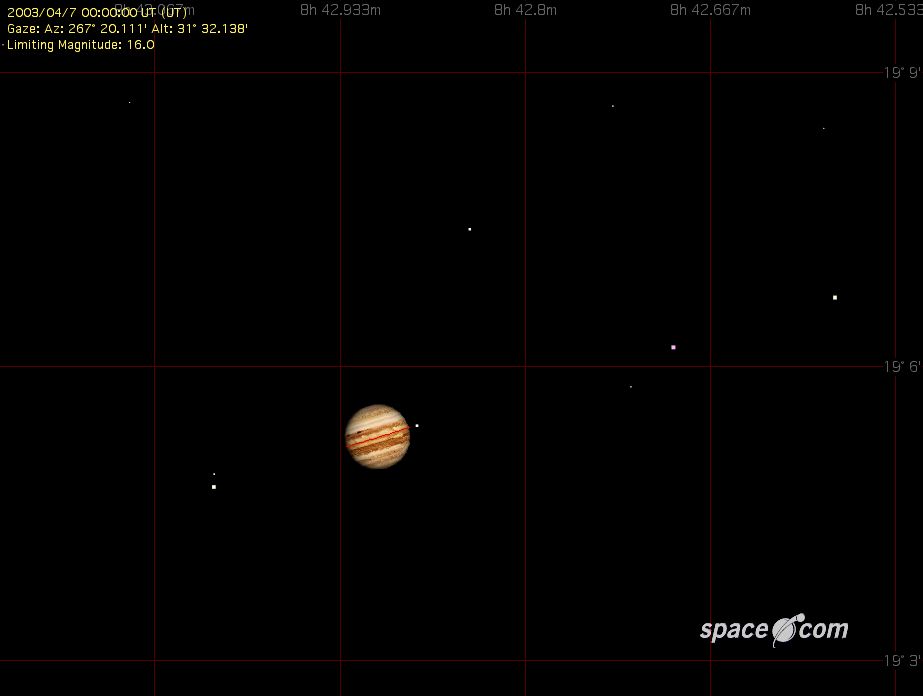

... and from Max Valier Observatory and New Jersey:

... and from Nyrola Observatory (Finland)

... and from Livermore (CA, USA)


... and more details on the Pic du Midi observational circumstances:


Field of view on April 07, 00h UT, as seen from Pic du Midi:

The Earth seen from the the direction of Jupiter from 06 April 2003 at 23:00 UT to 07 April 2003 at 07:00 UT, at one hour intervals. Note that the times at Jupiter take into account the light travel time (about 40 mn).



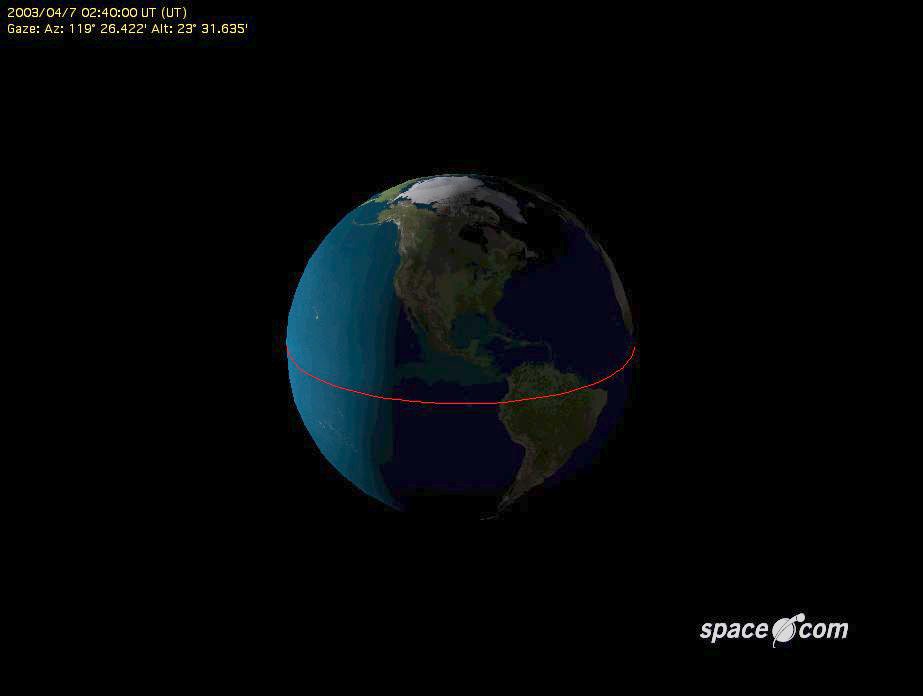





About the background image: the Atacama desert, near the border between Chile and Bolivia. The volcanoes in the skyline culminate at 5000-5500 m above sea level. This photo was taken after the Pluto occultation of 20 July 2002 (B. Sicardy).
Back to the home page